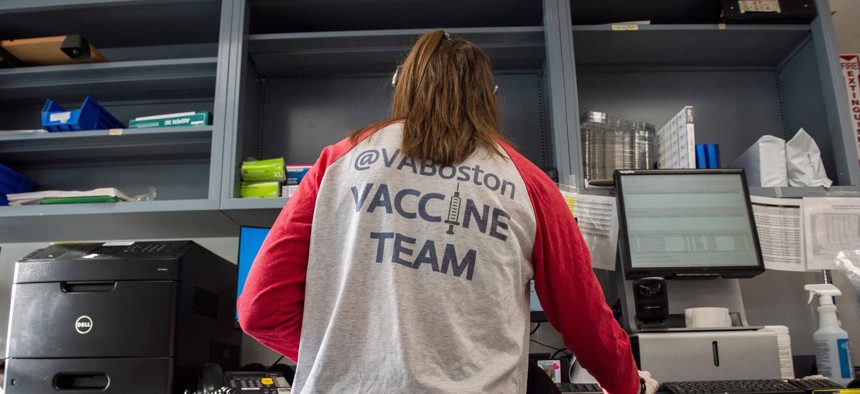
Home base primary care Pharmacist Erin Emonds logs onto a computer before filling syringes with COVID-19 vaccines at the VA Boston Healthcare System's Jamaica Plain Medical Center in March 2021. JOSEPH PREZIOSO / Getty Images
VA lacks the emergency budget modeling to prepare for health crises like COVID, GAO says
The watchdog said that the Veterans Health Administration does not have the modeling capability to predict how much supplemental funding would be needed to address a black swan event like the pandemic.
Should another major health crisis like the COVID-19 pandemic occur, the Veterans Affairs Department may not have a way to calculate the additional costs needed to address it, a Government Accountability Office report said Thursday.
The report — which examined how the VA allocated the $36.7 billion in supplemental funding received during the pandemic — found that the department bolstered a myriad of health care delivery functions, as well as information technology capabilities to expand telehealth services, during the health crisis and have factored the costs continuing those some services into its fiscal 2024 budget.
However, the GAO said that with the COVID funds having expired in September 2023, the VA lacks the ability to model for future disasters and how much it will need to meet them.
“This type of modeling has been used by other federal agencies to prepare for catastrophic events,” the report said. “For example, the Federal Emergency Management Agency uses advanced analytical modeling to inform its flood insurance program and statistical modeling to determine baseline workforce staffing for future emergencies.”
GAO officials said that when the COVID pandemic emerged in 2020, the VA was not prepared to deliver supplemental funding estimates for how much it would need to address the crisis because it lacked both the historical knowledge and an analytical modeling capacity.
It instead informing its funding requests with information “such as reported COVID-19 cases
in China and the cruise industry’s early experiences with COVID-19,” alongside the department’s own response data and COVID-19 transmission levels for funding bills like the CARES Act, Families First Coronavirus Response Act and American Rescue Plan Act.
According to the report, VHA officials lack the analytical modeling needed to predict the costs of a catastrophe because it’s not within the scope of either its actuarial model used to develop the estimates, known as the Enrollee Health Care Projection Model, or actuarial consultant contract used to help inform it.
“Partly as a result of not having the modeling capacity to prepare estimates for catastrophic events, VHA needed to make multiple transfers of CARES Act funds to accommodate changing pandemic needs and was more general in its identification of needs when requesting ARPA funds,” the report said.
GAO also said that while VHA officials also adjusted the EHCPM to account for the impacts of the pandemic when they crafted the department’s fiscal 2024 budget request, they didn’t detail the key decisions VHA and its actuarial consultant made in developing this year’s model.
The EHCPM accounts for 84% of VHA’s health care budget estimate, including outpatient and inpatient health care services provided at VA facilities and community providers, over the course of two fiscal years —with some budget projections made three to four years out.
But the report said that VHA has not shared key decision detail from the EHCPM with either the VHA Office of Enrollment and Forecasting or VHA Finance.
“VHA does not document or share all key EHCPM decisions because there is no requirement to do so,” the report said, noting that a September 2023 standard operating procedure provides “instructions on the processes and deliverables” but does not require the documentation of key decisions that informed EHCPM scenarios with other stakeholders.
GAO offered two recommendations, including a crafting requirement to document and share the rationale for key EHCPM decisions with internal VHA stakeholders and enhancing the VA’s analytical modeling capacity to account for catastrophic events.
VA officials concurred with the recommendations and planned to charter a work group to evaluate appropriate models. However, GAO officials said “it is unclear from VA’s response how this workgroup will enhance VA’s modeling capacity,” and added that they will continue to monitor the department’s work on the issue.







